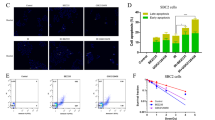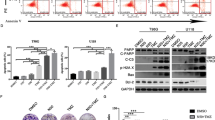Abstract
Most chemotherapeutical drugs kill cancer cells chiefly by inducing DNA damage, which unfortunately also causes undesirable injuries to normal tissues, mainly due to p53 activation. We report a novel strategy of normal tissue protection that involves p53/NF-κB coordinated metabolic regulation. Pretreatment of untransformed cells with low doses of arsenic induced concerted p53 suppression and NF-κB activation, which elicited a marked induction of glycolysis. Significantly, this metabolic shift provided cells effective protection against cytotoxic chemotherapy, coupling the metabolic pathway to cellular resistance. Using both in vitro and in vivo models, we demonstrated an absolute requirement of functional p53 in arsenic-mediated protection. Consistently, a brief arsenic pretreatment selectively protected only normal tissues, but not tumors, from toxicity of chemotherapy. An indispensable role of glycolysis in protecting normal tissues was demonstrated by using an inhibitor of glycolysis, 2-deoxyglucose, which almost totally abolished low-dose arsenic-mediated protection. Together, our work demonstrates that low-dose arsenic renders normal cells and tissues resistant to chemotherapy-induced toxicity by inducting glycolysis.
This is a preview of subscription content, access via your institution
Access options
Subscribe to this journal
Receive 50 print issues and online access
$259.00 per year
only $5.18 per issue
Buy this article
- Purchase on Springer Link
- Instant access to full article PDF
Prices may be subject to local taxes which are calculated during checkout






Similar content being viewed by others
References
Gudkov AV, Komarova EA . The role of p53 in determining sensitivity to radiotherapy. Nat Rev Cancer 2003; 3: 117–129.
Christophorou MA, Ringshausen I, Finch AJ, Swigart LB, Evan GI . The pathological response to DNA damage does not contribute to p53-mediated tumour suppression. Nature 2006; 443: 214–217.
Hinkal G, Parikh N, Donehower LA . Timed somatic deletion of p53 in mice reveals age-associated differences in tumor progression. Plos ONE 2009; 4: e6654.
Oeckinghaus A, Hayden MS, Ghosh S . Crosstalk in NF-kappa B signaling pathways. Nat Immunol 2011; 12: 695–708.
Ben-Neriah Y, Karin M . Inflammation meets cancer, with NF-kappa B as the matchmaker. Nat Immunol 2011; 12: 715–723.
Wang T, Marquardt C, Foker J . Aerobic glycolysis during lymphocyte-proliferation. Nature 1976; 261: 702–705.
Tergaonkar V, Perkins ND . p53 and NF-kappaB crosstalk: IKKalpha tips the balance. Mol Cell 2007; 26: 158–159.
Perkins ND . Integrating cell-signalling pathways with NF-kappaB and IKK function. Nat Rev Mol Cell Biol 2007; 8: 49–62.
Huang YL, Zhang JL, McHenry KT, Kim MM, Zeng WQ, Lopez-Pajares V et al. Induction of cytoplasmic accumulation of p53: a mechanism for low levels of arsenic exposure to predispose cells for malignant transformation. Cancer Res 2008; 68: 9131–9136.
Vousden KH, Ryan KM . p53 and metabolism. Nat Rev Cancer 2009; 9: 691–700.
Koppenol WH, Bounds PL, Dang CV . Otto Warburg's contributions to current concepts of cancer metabolism. Nat Rev Cancer 2011; 11: 325–337.
Lamm SH, Engel A, Kruse MB, Feinleib M, Byrd DM, Lai S et al. Arsenic in drinking water and bladder cancer mortality in the United States: an analysis based on 133 US counties and 30 years of observation. J Occup Environ Med 2004; 46: 298–306.
Kaplan HS, Brown MB . A quantitative dose-response study of lymphoid-tumor development in irradiated C57 black mice. J Natl Cancer Inst 1952; 13: 185–208.
Ak P, Levine AJ . p53 and NF-kappaB: different strategies for responding to stress lead to a functional antagonism. FASEB J 2010; 24: 3643–3652.
Andrew AS, Warren AJ, Barchowsky A, Temple KA, Klei L, Soucy NV et al. Genomic and proteomic profiling of responses to toxic metals in human lung cells. Environ Health Perspect 2003; 111: 825–835.
Mahata J, Ghosh P, Sarkar JN, Ray K, Natarajan AT, Giri AK . Effect of sodium arsenite on peripheral lymphocytes in vitro: individual susceptibility among a population exposed to arsenic through the drinking water. Mutagenesis 2004; 19: 223–229.
Acknowledgements
This work was supported by NCI/NIH grants 2 R01 CA085679 and R01 CA125144 (to ZMY). We are grateful to Dr Gigi Lozano (The University of Texas MD Anderson Cancer Center, Houston, TX, USA) for the p53-mutant mice. Mouse imaging was performed by Suresh Prajapati, gratefully acknowledged.
Author information
Authors and Affiliations
Corresponding author
Ethics declarations
Competing interests
The authors declare no conflict of interest.
Additional information
Supplementary Information accompanies this paper on the Oncogene website
Rights and permissions
About this article
Cite this article
Ganapathy, S., Xiao, S., Seo, SJ. et al. Low-dose arsenic induces chemotherapy protection via p53/NF-κB-mediated metabolic regulation. Oncogene 33, 1359–1366 (2014). https://doi.org/10.1038/onc.2013.81
Received:
Revised:
Accepted:
Published:
Issue Date:
DOI: https://doi.org/10.1038/onc.2013.81
Keywords
This article is cited by
-
SIRT1/P53 pathway is involved in the Arsenic induced aerobic glycolysis in hepatocytes L-02 cells
Environmental Science and Pollution Research (2023)
-
P53 vs NF-κB: the role of nuclear factor-kappa B in the regulation of p53 activity and vice versa
Cellular and Molecular Life Sciences (2020)
-
Arsenic trioxide ameliorates murine colon inflammation through inflammatory cell enzymatic modulation
Naunyn-Schmiedeberg's Archives of Pharmacology (2019)



